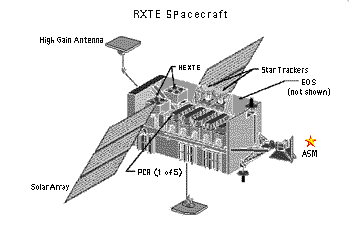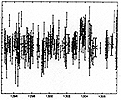For Educators

Getting Started with Background Information
Note: This was written before RXTE was decomissioned. We still provide data sets to use for these lessons, even though we no longer have live data.
In order for you to understand how information is acquired by RXTE, let's take a ride on an X-ray as it travels from space to our computer.
First of all, some rules that must be obeyed!
- No eating X-rays while in the All-Sky Monitor.
- Keep all arms and legs inside the ASM at all times.
- No breathing inside the ASM - since Xenon gas is not very nice to your
lungs.
- Watch out for fast moving photons.
- Never, and I mean never, touch the electron detector wires, unless you're an electron!
Now, all we have to do is find a good X-ray to hitch a ride on. An X-ray is born when matter is heated to a temperature of about few million degrees Fahrenheit. We can find temperatures that high in some binary star systems, so let's go check one out.
 |
Here's one on the left! The two stars in this system are Hercules X-1 and HZ Hercules. HZ Hercules is a relatively normal star; however, its partner, Hercules X-1, is very strange! It is what astronomers call a neutron star; it is the imploded core of a massive star that exploded. This giant explosion, called a supernova, stripped the outer layers of the star of leaving behind only what is essentially a ball of neutrons!
|
A neutron star is really, really dense. You can calculate how dense yourself using its mass, typically about 1.4 times the mass of the Sun, and radius, approximately 15 kilometers. You'll find that a neutron star's density is that of a neutron! Stumped?
Now because Her X-1 has the density of a neutron, it is so compact, and contains so much material, that it has a tremendously strong gravitational field. So tremendous, in fact, that it is pulling material in from nearby HZ Hercules. This process is called accretion and it causes this infalling material to heat up to incredible temperatures and give off X-rays. This can be seen in the above picture of a binary system. Now we just have to wait for an X-ray to come near and then we can hop aboard...
Whoa, here's an X-ray coming by on your left!
|
|
Quick! Jump on it!
|

We are now riding on an X-ray photon cruising towards the RXTE. As we approach, we see we're headed toward 3 gold-foil covered boxes attached to a boom sticking out of the satellite. We dive into the cloud of Xenon gas inside one of those boxes. Suddenly, our X-ray photon hits a Xenon atom, throwing us onto a dislodged electron. This electron hits another Xenon atom. Suddenly we're in a game of bumper cars with Xenon atoms and electrons smashing into each other. Finally this cloud of electrons we are in gets pulled into the electrical field of one of the detecting wires. When our electron hits this wire, it sends out an electrical pulse that the satellite computer reads. This happens a number of times every second.
Well, that was a fun ride! But now we have all this information that we need to get to the scientists on Earth. How are we going to do it? Since we don't have a 300 mile-long cable to use, we'll have to send our signal to a communications satellite that is equipped to send it to Earth. There are 2 satellites that do this. They are on different sides of the world, so they can relay information no matter where RXTE is.
 The data will be sent to a place on Earth called White Sands, New
Mexico. The White Sands ground station then sends it to the NASA's
Goddard Space Flight Center in Greenbelt, Maryland. The data then
travels through phone lines into your computer. Whew! That's a whole
lot of traveling! But amazingly enough, it only takes seconds!
The data will be sent to a place on Earth called White Sands, New
Mexico. The White Sands ground station then sends it to the NASA's
Goddard Space Flight Center in Greenbelt, Maryland. The data then
travels through phone lines into your computer. Whew! That's a whole
lot of traveling! But amazingly enough, it only takes seconds!
So how will this data look to me ? You have to see it to believe it, but all this data is made into graphs. These graphs are called light curves. Light curves tell us the intensity of X-ray photons over a period of time. By studying these, we can find out about all kinds of activities going on out in space, including stuff about our old friend Hercules X-1. For instance, when you look at the data for Her X-1, you'll find out that its companion star causes periodic eclipses!
So go and explore! The Universe is waiting to be studied and you have the tools to do so with ASM light curves!
 Welcome |
 Lesson Plans |
 Take Me To Your Data |


